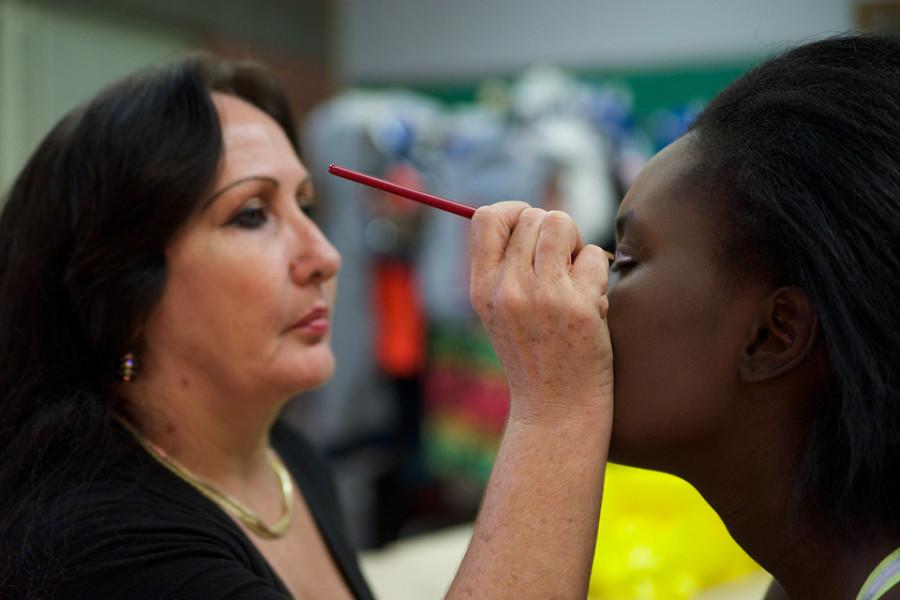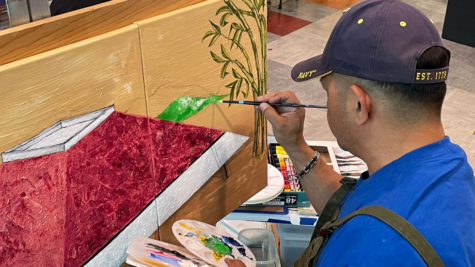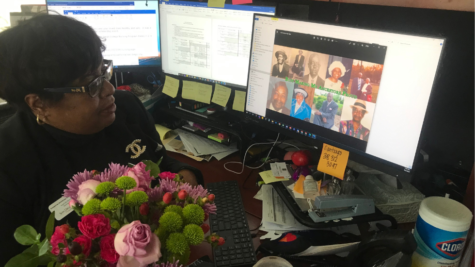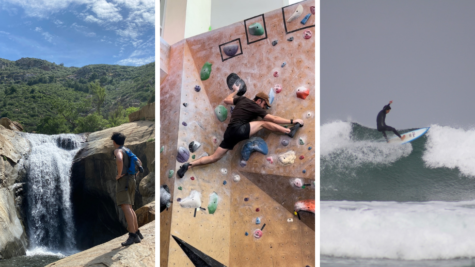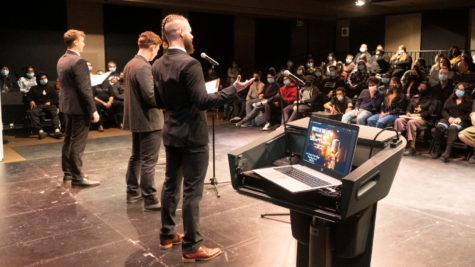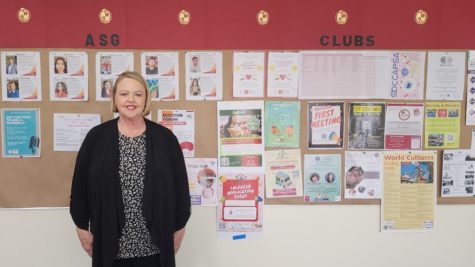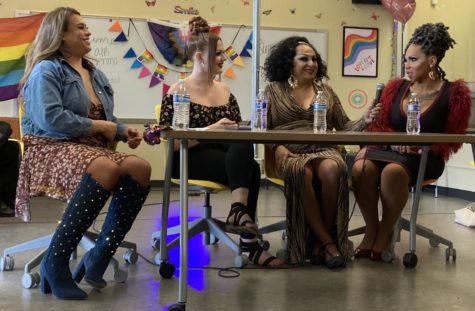Setting the Scene: A Look Behind the Curtain at What Makes a Musical at City College
With wardrobes selected for performers, cosmetology students prep the cast for the final dress rehearsal of “In the Heights” before the show’s debut on Apr. 11. Photo credit: Troy Orem
May 14, 2014
There is a vibrancy in the aura around the theater
for San Diego City College’s centennial spring musical production, “In the Heights.” It is half past 7 p.m. and you can
already feel the electrifying hum as the audience walks quickly to the ticket
booth in anticipation of curtain call.
Whispers pass through the audience as they murmur and nod to each other. A lady in a floral shawl leans over to her friend and confides memories of stage fright in her youth. A few people in the audience even point at the edge of the curtain and wonder what is happening back stage.
Meanwhile, Dominic Accardi, assistant costume designer and makeup director, is in the dressing room breaking off his conversation mid-sentence as two dancers burst in and say neither have been able to find their shoes since last night’s performance. Accardi rushes off to help locate the shoes that have gone MIA.
Actress Erika Osuna, playing female lead Nina Rosario, has her eyes closed and her lips puckered as a student make-up artist leans forward to paint her lips a bright crimson red. Rosario is sitting in a chair facing a tall mirror running the length of the counter top. There is a mirror on opposite walls of the narrow makeup room.
“Over 35 students from cosmetology will be here over the next three weeks to do hair and makeup,” Patricia Higgins, stylist manager, said during the dress rehearsal a week previous. Higgins is a senior student working on her associate degree in City College’s Cosmetology program. She is working closely with Accardi in following his lead on the style for makeup and hair.
“We’re going for a stylized Caribbean hip hop look. Very urban,” Higgins said, referring to many of the ensemble.
It is unusual to need so many makeup artists for a production, but “In the Heights” has a large cast with several dancers.
“It’s been a decade since cosmetology has worked with the theater department,” Higgins said, adding that she hopes it will continue because it is a great opportunity for students to get hands-on experience in another career branch for a makeup artist.
Michael Glover, stage manager, is seen standing with his fellow City College student production crew. “As a stagehand, you do everything from building sets, hanging lights, sound and assist the director,” Glover said. “I absolutely love all aspects of theater or concerts. Putting together a production and then seeing it live.”
Glover will be transferring to San Diego State University for theater design and technology next year and is working on completing his apprenticeship with the International Alliance of Stage Working Employees labor union. Glover said he started with the union at the bottom a couple of years ago, but his pay has never been lower than $15 an hour. While his education isn’t required, he said, “It’s easier to get further if you know what you are doing. Looks good on the resume, too.”
Accardi has returned and is looking comfortable in this environment of pre-show activity. The latest costume emergency has clearly been resolved. Standing next to him, makeup artist Sabrina Bray points her thumb toward Accardi and said, “He’s the brainchild of the whole makeup concept.”
Accardi responded by trying to make light of her compliment. “Naaah …” he said, pointing back, “She rocks.”
Accardi entered the Theater Arts program at City College in the fall of 2013 after a near decade-long break in the field. He said he dreams of moving to Italy and joining a production in Europe.
Even with more than 17 years of professional experience in theater and doing costuming for more than 10 shows, Accardi said that he is thrilled with the opportunity to work with two of City’s professors, costume designer Andrea Singer and director June Richards.
“I have learned a great deal from both Andrea and June,” Accardi said.
“Andrea is fantastic. Her enthusiasm is infectious,” he said. “Have you seen her outfits? Her own work is amazing.”
Being in Singer’s costuming class has given him a whole new appreciation of sewing principles. “I honestly didn’t know how to do a lap zipper,” Accardi said. “The way she explains things in class, she goes into far more detail.”
As Singer’s assistant costume designer for “In the Heights,” Accardi is not only working closely with Singer, but with Richards, as well. “I like working with June. June is very clear in what she wants in a show. As a designer, you want that,” he said.
Accardi provided some insight into the pre-production process for costume designing. “A costume designer will receive a script to a new production two weeks before casting calls begin,” he said. “The first step is to read through the script and mark up where the changes are needed.”
This helps to determine how many clothing outfits or costumes will be needed for each character. A designer will begin to conceptualize possible looks. After auditions and the cast is selected, there is a key meeting early on between the show’s director and costume designer. This is where the designer can present their ideas and hear the director’s concepts.
Accardi advised that, “As a general rule, always bring four to five different concepts to show a director.”
Collaboration includes taking the set design into account. Colors from the set will often be mirrored in the costumes. It’s a delicate act to find the balance between having an actor stand out (not blending into the set or the other people around) while making sure the costumes stand out, without taking over.
“The worst is to pull the audience out of the story,” Accardi said. “That’s the biggest thing about doing costumes. You have to dress each character accordingly to their individual background and to the importance of need for the audience focus on that character.”
This meeting between show director and costume designer not only establishes the overall direction of the show, but it also sets the tone for the working relationship.
In terms of his experience in working with Richards, he said, “You can be straight forward,” with an emphasized pause, ” … just as long as you present yourself in a respectful and fair and balanced way.”
This interaction between designer and director is so important that Singer has student presentations in her class curriculum. “A popular assignment in her costuming class is the traveling character presentation,” Accardi said.
This was a 3D collage presentation on a wood board with composite pictures artfully put together to show the story of the character. These are referred to as “mood boards,” Accardi said. “It gives color themes, pattern samples and overall style of their character.”
“A couple of students are putting together their costumes from this project and planning on presenting them at Comic-Con this summer,” Singer said. “They are just amazing. I am very pleased with the work all of my students have done this semester.”
Her class is as hands-on experiential as she can create. Periodically during the semester, her class will take a field trip down to a local fabric store, where the students pick out their patterns and fabrics. “This class is not just theory. They will do a sampler and learn how to stitch,” Singer said.
Singer said she encourages her students to transfer onto any four-year degree school, but admits that she favors her alma mater, University of California, San Diego: “They have an amazing internship program at UCSD with the La Jolla Playhouse.”
Costuming is a passion for Singer, and she sees clothing not just as a fashion statement but as an interactive experience from where she wishes to convey important concepts through artistry.
“I want to make socially relevant art and design installations which look at how you are impacting the world,” Singer said.
As costume designer for “In the Heights”, Singer said she’s had an exciting time working with Richards and co-director and choreographer Alicia Rincon.
“We work so closely together for so long, we start almost completing each other’s sentences,” she said.
The collaboration between departments — both the professional staff and student staff — has been a unique trait to this spring musical production. It gives a sense of family, Singer said “It’s like coming home.”
“Working with Dominic has been a real joy. We worked together to create ‘the bible’,“ Singer said. The bible is an in depth notebook with the measurements of each cast member, photos of the cast and pictures of clothing representing the style or look the costume designer is hoping for that character.
Singer explained that there are two ways to do costuming for a show — either you “buy” or you “build.” Building would mean designing and constructing a costume from scratch. This is a far more elaborate, expensive and time-consuming process.
“It would involve a cutter, a pattern maker, a stitcher, a costume renderer and an assembler,” Singer said.
“In the Heights” was “off the rack,” meaning that the show was bought. “It’s much easier and less expensive to purchase the clothes and only alter as needed,” Singer said. She encouraged shopping as economically as possible and to check out discount stores.
In this production, they are looking for a “super colorful, diverse, urban hip hop look, with a gritty flavor,” Singer said. ” … and a touch of African and Caribbean.”
After all costumes have been shopped, immediately before dress rehearsals, the team will have each cast member try on clothing for Singer, Accardi and Richards to review. Once the appropriate look has been found for the actor or dancer, the tags are cut away and the selection is recorded.
During rehearsal, there is a “costume parade” where the design team and directors watch the cast move on stage. This is valued time where the team watches with their critical eyes to notice any detail that could cause problems or can be improved upon.
“You have to be aware that you are sculpting movement in a costume,” Singer said. They watch to make sure the actors can do their movements easily without being restricted by clothing and look attractive while in action.
Dancing is a major part of this production, with more than 20 dancers in routines throughout the performance. Alicia Rincon created the choreography for the production.
“I grew up with salsa in my family’s living room,” Rincon said. She enjoyed designing the choreography for the club-style salsa in the production. Assistant Bernadette Ondevilla created the hip hop dance numbers, which caused a lot of excitement among the dancers.
“Everyone in the production is so divine and talented,” Rincon said, adding that she loves working with diverse artists and crossing creative disciplines. “I am a collaborator at heart.”
Richards was passionate about this production, claiming that this was the perfect fit for City College during the centennial as, “Diversity is an inherent part of City College.”
The Tony Award-winning musical is set in the New York neighborhood of Washington Heights. The parallel to a community with diversity in cultures and the social issues examined makes this story relevant to San Diego.
“I am thrilled to be working with this group of professionals, the staff and the student team working on this production together — it is really special this year,” Richards said.
This is an inter-discipline show bringing together talented professors and students under the Visual and Performing Arts umbrella. “I’m in love with their artistry, their willingness to collaborate and their sense of humor,” Richards said.
With a gleam in her eye, Richards said she aspires to take the department’s growth further ” … to allow for more student-centric plays, written and directed by students.”
Richards said she hopes that this “In the Heights” production will open the perception of San Diego’s downtown community to recognize the diverse talent pool at City College’s Saville Theatre.


